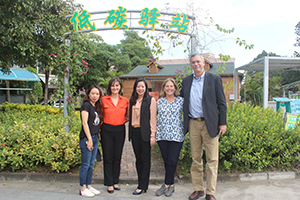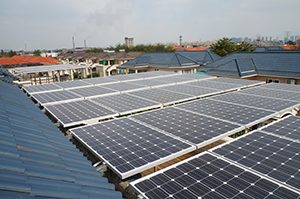This blog is by ISC board vice-chair, LuAnn Bennett. LuAnn is president of the Bennett Group in Washington D.C.
We all know that China is the world’s largest greenhouse gas emitter, but what’s easy to forget is why that’s the case: the country is enormous and rapidly urbanizing.
As a real estate developer in Washington D.C., I’ve spent the last 37 years thinking about urbanization and its impact on the built environment. Visiting China to learn more about the work of ISC — and to broaden my understanding of the challenges and opportunities urbanization creates — significantly expanded my views.
When Americans think about urban China, images of smog-choked cities immediately spring to mind. While air pollution in the country is significant, visiting ISC’s longstanding Xiaolan project, I was greeted with lush greenery, organic vegetable gardens, and rooftop solar panels. It looked more like Berkeley California than what I expected for a neighborhood in a Chinese city larger than Houston, Texas.
Speaking with He Yiqing, executive director of ISC partner, the Xiaolan Low Carbon Development and Promotion Center, I learned that much I was seeing was the result of a concerted effort to educate area residents about how to live with a lower carbon footprint. The Chinese national government has a strong commitment to address climate change, and that commitment has been passed down to provinces and cities, but city officials and residents struggle to transform commitment to action.

This is where ISC comes in. A trusted partner in communities’ sustainability planning and execution for more than 25 years, ISC specifically tackles the execution gap – helping local leaders unleash their own power to transform their communities. As a businessperson, I was astounded to learn how cost-effective an approach this can be. In China, ISC has already successfully leveraged $1.9 million in grant funding into a potential of $40 billion in private investment in low-carbon development in four cities.
Now, ISC is doubling (or tripling!) down on that success – working with 12 new cities under the newly-formed Low Emissions Cities Alliance, a $10 million partnership funded by USAID and Energy Foundation China (EFC).
Our Chinese partners, are eager to learn what we know, avoid the hard lessons of missed opportunities and mistakes, and fast-track to a future that may see the slowing of growth, but does not sacrifice environmental integrity for unfettered economic opportunity.

We similarly have so much to take from the Chinese context – especially as they learn from, innovate upon, and in some cases exceed, the low-carbon development work of the United States. I left China energized and inspired by the work of ISC’s Chinese partners. It served as a warm reminder that local leaders are ultimately in control of their climate destiny.
Together, we have a long way to go to reduce the global emissions that harm us now and for generations to come. The deep engagement of ISC in places like China – where real tools, skills, strategies and results are most needed – is a profoundly hopeful thing to see. Despite what can feel like overwhelming challenges, it’s not too late. A Chinese proverb tells us: the best time to plant a tree was twenty years ago. The second best time is today.

